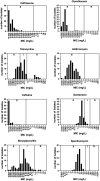Antimicrobial susceptibility of Neisseria gonorrhoeae isolates and syndromic treatment of men with urethral discharge in Kingston, Jamaica, 2018-19
- PMID: 34557895
- PMCID: PMC8730701
- DOI: 10.1093/jac/dkab340
Antimicrobial susceptibility of Neisseria gonorrhoeae isolates and syndromic treatment of men with urethral discharge in Kingston, Jamaica, 2018-19
Abstract
Objectives: To quantitatively determine the antimicrobial susceptibility of clinical Neisseria gonorrhoeae isolates from men with urethral discharge in Jamaica and to describe the syndromic treatment therapies administered.
Methods: Urethral eSwabs (Copan) were collected from 175 men presenting with urethral discharge to the Comprehensive Health Centre STI Clinic, Kingston, Jamaica. Clinical information was collected and MICs of eight antimicrobials were determined for N. gonorrhoeae isolates (n = 96) using Etest and interpreted using CLSI criteria.
Results: The median age of the subjects was 28 years (range: 18-73 years) with a median of 2 sexual partners (range: 1-25) per male in the previous 3 months. All examined N. gonorrhoeae isolates were susceptible to ceftriaxone (96/96), azithromycin (91/91), cefixime (91/91) and spectinomycin (91/91). For ciprofloxacin and gentamicin, respectively, 98.9% (91/92) and 91.3% (84/92) of the isolates were susceptible and 1.1% (1/92) and 8.7% (8/92) showed intermediate susceptibility/resistance. For tetracycline and benzylpenicillin, respectively, 38.0% (35/92) and 22.0% (20/91) of the isolates were susceptible, 52.2% (48/92) and 74.7% (68/91) showed intermediate susceptibility/resistance and 9.8% (9/92) and 3.3% (3/91) were resistant. Syndromic treatment was administered as follows: 93.1% received 250 mg of ceftriaxone intramuscularly plus 100 mg of doxycycline orally q12h for 1-2 weeks and 6.9% received 500 mg of ciprofloxacin orally plus 100 mg of doxycycline orally q12h for 1 week.
Conclusions: Ceftriaxone (250 mg) remains appropriate for gonorrhoea treatment in the examined population of men in Kingston, Jamaica. Surveillance of N. gonorrhoeae AMR should be expanded in Jamaica and other Caribbean countries to guide evidence-based treatment guidelines.
© The Author(s) 2021. Published by Oxford University Press on behalf of the British Society for Antimicrobial Chemotherapy.
Figures

References
Publication types
MeSH terms
Substances
Grants and funding
LinkOut - more resources
Full Text Sources
Medical

